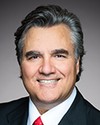Good morning, Madam Chair and committee members.
Thank you for this opportunity to describe the actions we've taken on soundscape management, and to answer your questions as part of efforts to assess the impact of aircraft noise in the vicinity of Canada's major airports.
Under the terms of its lease with Transport Canada, Aéroports de Montréal, or ADM, is responsible for managing and operating Montréal-Trudeau airport and the Mirabel Aeronautics and Industrial Park.
Over the years, Montréal-Trudeau has grown into an aviation hub and the third-largest airport in Canada. The airport serves 151 destinations and is home to 37 air carriers. As a result, it's the most international Canadian airport, since 41% of its passengers travel outside Canada and the United States. Montréal-Trudeau plays a significant role in the economic development of the greater Montreal area, with almost 29,000 direct jobs and some 200 companies on its site.
Soundscape management is and always has been a priority for Aéroports de Montréal. ADM's role is to ensure balance between the airport's growth as a key player in the development of the greater Montreal area and continued harmonious coexistence with its community. This is an integral part of our mission, and we're making sustained efforts to maintain that balance.
We develop our plans by incorporating the principles of the ICAO's balanced approach. We also work with our partners to mitigate the impacts on neighbouring communities of the activities involved in operating an international airport. These partners are the following.
Transport Canada is the regulatory body tasked with ensuring enforcement of the acoustical usage criteria and noise-abatement measures. Transport Canada is empowered to sanction pilots and carriers that violate those rules.
NAV CANADA is responsible for providing air navigation services, which means air traffic control.
Lastly, the airlines are required to fly their aircraft according to the operating hours in effect and comply with the flight procedures at Montréal-Trudeau. They’re also responsible for their aircraft fleets.
As the airport authority, Aéroports de Montréal is responsible for developing a soundscape management plan, setting up a soundscape management advisory committee, and handling complaints regarding noise.
To that end, Aéroports de Montréal put forward a preferential runway system for night-time operations. It ensures compliance with the operating hours in effect at Montréal-Trudeau and performs thorough follow-ups on requests for exemptions.
During the past 15 years, despite significant increases in passenger numbers, the total number of aircraft movements has remained relatively stable. It would therefore be wrong to conclude that Montréal-Trudeau's growth necessarily means an equivalent or proportional increase in the number of movements.
Aircraft today are larger, carry more passengers, and are less noisy. Technical and technological improvements have resulted in major noise reduction over the past decade.
To measure noise levels, Aéroports de Montréal has eight noise-measurement stations, including one mobile unit. ADM publishes the equivalent continuous sound levels, or the Leq, recorded by the various noise-measurement stations located around the airport.
These stations are positioned strategically along the runway centrelines. The equipment is installed and calibrated by independent professionals. The system is linked to NAV CANADA radar data, which ensures that the noises recorded are correlated to aircraft movements.
Night flights are a significant concern for our soundscape management program. Managing flight schedules is a complex exercise for air carriers. On the one hand, the passenger community wants access to a variety of destinations at the best possible cost, and on the other hand, reducing the number of night flights is a crucial requirement.
ln addition to studying all requests for exemptions, ADM enforces the flight schedule restrictions in effect at Montréal-Trudeau. ADM meets regularly with air carriers that have operated flights outside its normal operating hours to demand that they implement action plans to remedy these situations.
Montréal-Trudeau airport is open 24 hours a day to aircraft weighing less than 45,000 kilograms. These are mainly propeller-driven aircraft and CRJ-type planes.
Heavier aircraft are subject to restricted operating hours. Jet aircraft weighing more than 45,000 kilograms must land between 7 a.m. and 1 a.m. and take off between 7 a.m. and midnight. ADM may grant exemptions as stipulated in the Canada Air Pilot.
Lastly, in co-operation with its soundscape management advisory committee, Aéroports de Montréal is continuing to develop further noise-abatement measures to benefit the Montreal community. To that end, an important action plan will be presented shortly to the committee members.
The plan comprises 26 actions in seven categories. These categories are restrictions on night flights; the use of quieter aircraft; noise-abatement procedures at takeoff and landing; the publication of reports and indicators that are more meaningful to the communities; the update of the complaints management policy; land-use planning; and the involvement of neighbouring communities.
Our objective is to reduce the impact of the activities related to airport operations; to provide incentives for air carriers to use the quietest possible aircraft; and to reduce the number of flights taking place during restricted operating hours.
Residents of large cities are exposed to different types of noise from a variety of sources, such as road networks, vehicles, railways and air traffic. It’s therefore important that these sources be properly identified.
ln that context, regarding the land-use planning category, I want to reiterate that ADM endorses the recommendation by Montreal’s public health directorate to enforce action 18.1 of the City of Montreal’s urban plan. This plan calls for the establishment of a coordinating committee with the Ministère des Transports du Québec and the various organizations and firms involved in freight transportation, including CP and CN, the Montreal Port Authority and Aéroports de Montréal, in order to limit noise pollution in residential areas. On multiple occasions, we’ve invited the City of Montreal to establish this type of committee, while pledging our collaboration.
Thank you.



